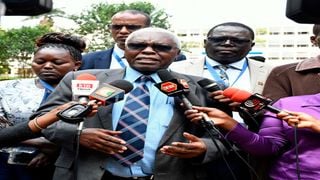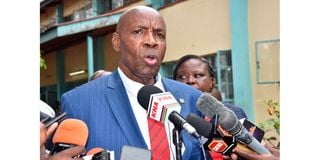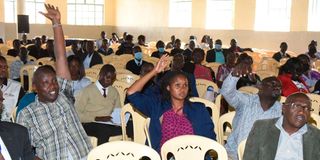
Presidential Working Party on Education Reform Chairperson Raphael Munavu addressing journalists during public hearings.
| File | Nation Media GroupEducation
Premium
The evolution of Kenya’s education system
When Kenya attained independence in 1963, the government committed itself to fighting three things, namely poverty, ignorance and disease. This set the priorities for its development agenda.
The first national development plan, 1964-70, clearly articulated the strategies to tackle these challenges and prioritised education as the vehicle for social, economic and political evolution of a nascent state.
With independence, the colonial administrators, public service workers and business executives exited the scene and the role of managing the nation fell on Africans, hence the urgent need to create a pool of competent human resource to drive the economy.
Since the country was emerging out of colonial experience where wealth had been appropriated and concentrated in the hands a few white and Asian elites, while Africans had been disempowered and their cultural practices denigrated, a new paradigm was required.
The imperative was to craft a new and transformative education that would equip Africans with vital skills for a modern economy. Consequently, the government set up a commission of education in 1964 under the chairmanship of Prof Simeon Ominde and charged it with the task of crafting a roadmap for the country’s education system and attendant policies.
Under the colonial rule, education was segregated whereby Europeans and Asians went to high-end schools that equipped with knowledge, skills and aptitude leading them to lucrative professions and top ranks in government service.
Africans, on the hand, were taken through elementary learning with focus on what was known as Three Rs – reading, writing and arithmetic – with emphasis on vocational skills to make them labourers.
Also Read: Education for the rich - Concern as thousands set to miss out in new varsity funding model
The Ominde Commission had seven broad objectives, among them, providing human resource, fostering national unity, mobilising resources and promoting Africa’s cultural practices and ideals.

Education Cabinet Secretary Ezekiel Machogu.
It made far reaching recommendations that were adopted by the government. The commission made fundamental recommendations, key among them, proposing a uniform education system and abolishing clustering of schools based on race.
Thus, the Ominde Commission recommended the 7-4-2-3 system of education that served the country for nearly two decades, until its replacement with the 8-4-4 system in 1985.
It also recommended setting up of a single employer to bring all teachers together under one administration unlike the practice in the colonial rule where teachers were employed by different entities, including churches and local authorities.
In addition, the Commission proposed provision of free primary education, which was later to be introduced in 1974, covering Standards One to Four.
Arising out of the recommendations, the government embarked on a major programme of expansion of schools and training of teachers to meet the needs of eligible children seeking education. Evidence of growth became manifest with exponential rise of enrolment and expansion of schools within the first decade of independence.
Starting from 1963, primary schools had a gross enrollment of 891,553 learners but this rose dramatically to 1,428,000 in 1970 and doubled to 2,881,000 in 1975.
Similar trends were recorded at the secondary school level, where enrollments rose from 30,000 in 1963 to 126,900 in 1970 and doubled to 217,400 in 1975.
At the university level, the number of students increased from 370 in 1963 to 2,300 in 1970/71 and 5,140 in 1975/76 academic year. Indeed, this set the trajectory for the country’s massive expansion at all levels that continued to date.
The expansion of schools and massive growth of enrollment reflected the development of the country’s economy.
Between 1963 and 1972, Kenya recorded an average economic growth of 6.6 per cent annually, marking what economics have since dubbed the golden years.
Also Read: Inside new funding model for universities
Favourable economic conditions are an impetus for educational development. School graduates are assured of job and business opportunities and resources are readily available to support teaching and learning.
However, the blissful years were dampened by the oil shock of 1973 and later 1979 that saw prices rise astronomically, throwing economies into turmoil. Kenya like other countries got a rude shocker. Economic plans had to be reworked.
Education and other social sector services bore the brunt.
Combined with other realities such as emerging challenges of globalisation and geo-political realignments, Kenya was forced to rethink its education.
In response, the government set up the National Committee on Education Objectives and Policies in 1975, headed by Peter Gachathi, then Permanent Secretary in the Ministry of Education.
Its broad mandate was to review the national objectives of education and policies and to align them with the emerging realities of the day and also advise on the best education system for the country. The Committee concluded and handed in its report in October 1976.
Its main recommendation was reorganisation of the education system, proposing a nine-year basic education cycle and four-year senior school.
This meant expanding the duration of primary school from seven to nine years, with the last two years being named junior secondary school and offering pre-high school education.

Members of the public give their views to the Prof David Some-led Presidential Working Party on Education Reform chairman in Eldoret on November 11, 2022.
The four-year senior school comprised Forms Three to Six, which among others, was intended to offer both academic and vocational subjects, the latter to prepare learners who did not qualify to join university to terminate their studies at that point and get direct entry into the labour market.
However, the Gathathi Report was never implemented and remains a reference text for education scholars. Even so, some of its recommendations such as Junior Secondary School found place in the current Competency Based Curriculum being implemented in schools.
Similarly, its recommendation for expansion of university education came to pass years later, as they were taken up by commissions that came after it.
Notably, Moi University was established in 1984 following the recommendations of the Report of the Presidential Working Party on Second University of 1981 chaired by Collins Mackay.
In close sequence, Kenyatta University College, erstwhile a constituent of the University of Nairobi, was upgraded and became a full-fledged university in 1985, just as the Commission for Higher Education was established in 1986 to coordinate university education.
In effect, the Gachathi Report set up the foundation for future developments of education.
But the monumental transformation of Kenya’s education system came in the early 1980s.
Presidential Working Party
In 1981, President Daniel arap Moi, who had ascended to power in 1978 following the demise of the founding President Mzee Jomo Kenyatta in August of that year, appointed a team to advise the government on university education.
It was named the Presidential Working Party on Secondary University Education in Kenya and chaired by Dr Collins Mackay, a Canadian academician, and its core mandate was really to advise on university education.
As it came to pass, the Presidential Working Party went beyond its mandate and recommended a change of the country’s education system and that ushered in the 8-4-4 that was implemented from 1985.
The rationale for the 8-4-4 was to equip learners with knowledge and practical skills such as technical and vocational competences to make them employable.
It was envisaged that the curriculum would help learners to gain practical skills and competences to enable them to become self-reliant, thus steering them away from the white-collar jobs to a more practical orientation. The curriculum was broad-based but heavily laden, which became its undoing, for sooner rather than later, it emerged that learners could not cope, and it had therefore to be revised.
Two reviews conducted in 1995 and 2002 revealed that the curriculum was heavily loaded across the various subjects at primary and secondary levels and consequently, led to drastic changes in the content.
But these reviews had the unintended consequence of rendering the curriculum insufficient to serve the needs of a nation at the edge of industrial and technological take-off, thus the 8-4-4 lost its lustre.

Higher Education Loans Board CEO Charles Ringera answers questions from journalists at State House in Nairobi on May 3 after the announcement of the new university education funding model.
Global initiatives such as the Education for All (EFA) and the Sustainable Development Goals all lent credence to the need for revision of the curriculum.
In 2012, the government set up another taskforce that was led by Prof Douglas Odhiambo, a past vice-chancellor of Moi University, to advise on a new education plan.
Competency Based Curriculum
The team published the Report of the Task Force on the Re-alignment of the Education Sector that proposed a new education system that emphasised competence rather than mere knowledge acquisition.
This set the state for the current Competency Based Curriculum (CBC) being implemented in schools since 2017.
Theoretically, CBC is a model and not an education system. But for ease of reference, the system is divided into four distinct levels, early years that take two years, primary education that takes six years, junior secondary that goes for three years, senior school, also three years and then university and tertiary that take a minimum of three years (2-6-3-3-3).
CBC is anchored on seven pillars, namely, communication and collaboration, self-efficacy, critical thinking and problem solving, creativity and imagination, citizenship, digital literacy and learning to learn.
The pioneer CBC cohort joined Junior Secondary School this year and on reflection, the new curriculum is going through teething problem marked by inadequate funding, dire shortage of teachers and poor infrastructure.
Matters are made worse by the fact the current administration has not demonstrated a clear plan of steering the new system.
A review of Kenya’s education demonstrates its strong nexus with politics and economics of the day. In the early years of independence until 1970, the government invested heavily in education with remarkable structural, administrative and professional results.
However, the economic declines of the late 1970s that deepened into the 1980s was painful for the education sector.
World Bank and International Monetary Fund (IMF) introduced Structural Adjustment Programmes (SAPs) in the 1980s intended to pull developing nations, Kenya, included out of economic stagnation. But the impacts were severe.
Countries were forced to cut spending on social sectors such as education and health and that led to the introduction of cost-sharing.
The government stopped spending on education and instead asked parents and communities to contribute to building schools and meeting most of the recurrent costs. Numerous levies were introduced in primary schools, fees raised in secondary schools and universities.
The net result was a massive drop in enrolments.
For example, figures by the Kenya National Bureau of Statistics indicated that some 1.6 million eligible children were out of school in 1999.
When the National Rainbow Coalition (Narc) won the General Election of 2002, the first decree by President Mwai Kibaki was to abolish all levies and declare free primary education.
And instantly, the enrolments shot up. Subsequently, in 2009, the Coalition Government introduced subsidies in secondary school, paying tuition fees for all students, and that reduced the fees. This has continued to date.
However, the commitment is waning and perhaps, due to large enrolments and declining government revenues, the remittances to schools have been intermittent. Secondary schools, in particular, are reeling under heavy debts.
But the major challenge is with universities. Years of massive expansion and poor planning have created a monumental disaster in the higher education sector.
Since the introduction of cost-sharing policy following the recommendations of the Report of the Presidential Working Party on education and manpower training for the next decade and beyond (Kamunge report), things have never been the same. Government funding has declined systematically since it introduced cost-sharing policy in universities in 1991.
The result has been haemorrhaging of the universities manifested in inadequate teaching and learning infrastructure, crippling lecturers’ shortage and large number of students and which have severely compromised quality of education.
Universities no longer enjoy any level of stability given frequent strikes by lecturers and students, the former over poor pay and the latter poor services.
University funding
Recently, the government set out to redefine the funding model for universities, shifting from the previous system where government supported all students who qualify for admission and now focusing only on the needy.
Details of the new model have not been properly articulated but the net sum is that the government will only finance a few needy students and leave the rest to fend for themselves.
At this point in time, the current administration has the onerous task of revitalising the education sector.
President William Ruto appointed a working party in November under the chairmanship of Prof Raphael Munavu, previously a vice-chancellor of Moi University, to advise on the future of education but the full outcome of its work has not been made public.
The working party needs to complete its work and provide the roadmap for education.
As we mark the 60th anniversary of independence, the Ruto administration has to rethink the education sector in a more strategic way.
The sector must be properly funded. What is paramount is proper planning and implementation of CBC, effective teacher management and fair compensation, reforming university education and strengthening technical and vocational training and education.
Achieving this requires proper leadership.
- David Aduda is NMG’s Consulting Editor and Education Specialist. [email protected]





